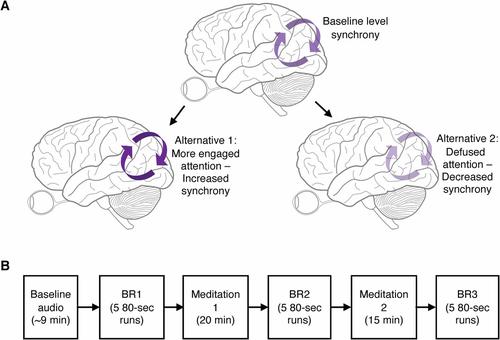当前位置:
X-MOL 学术
›
Ann. N. Y. Acad. Sci.
›
论文详情
Our official English website, www.x-mol.net, welcomes your feedback! (Note: you will need to create a separate account there.)
Neural correlates of nonjudgmental perception induced through meditation
Annals of the New York Academy of Sciences ( IF 5.2 ) Pub Date : 2021-04-23 , DOI: 10.1111/nyas.14603 Sucharit Katyal 1 , Philippe Goldin 1
Annals of the New York Academy of Sciences ( IF 5.2 ) Pub Date : 2021-04-23 , DOI: 10.1111/nyas.14603 Sucharit Katyal 1 , Philippe Goldin 1
Affiliation

|
Ambiguous sensory stimuli provide insight into the dynamics of the human mind. When viewing substantially different images in the two eyes (i.e., binocular rivalry (BR)), perception spontaneously fluctuates between the two images along with patch-like mixtures of the two, with limited ability to control such fluctuations. Previous studies have shown that long-term meditation training can enable a more stable perception by reducing such fluctuations. Using electroencephalography, we investigated the neural bases of perceptual stabilization in long-term meditators (LTMs) and age-matched meditation-naive control participants. We measured BR alternations before and after participants practiced meditation. We expected that perceptual stabilization through meditation could occur via one of two neurocognitive mechanisms: (1) a more engaged/effortful attention reflected by increased long-range phase synchronization between early visual sensory and higher-level brain regions, or (2) a disengaged/nonevaluative form of attention reflected by decreased phase synchronization. We found that compared with control participants, LTMs were in a significantly longer mixed perceptual state following concentrative meditation practice. The increase in mixed percepts across individuals was strongly correlated with reduced parietal–occipital gamma-band (30–50 Hz) phase synchrony. These findings suggest that concentrative meditation enables a nonevaluative perceptual stance supported by reduced communication between hierarchical visual brain regions.
中文翻译:

通过冥想诱发的非判断性知觉的神经相关性
模棱两可的感官刺激可以洞察人类思维的动态。当在两只眼睛中观看完全不同的图像(即双眼竞争 (BR))时,感知会在两个图像之间自发地波动,以及两者的斑块状混合,控制这种波动的能力有限。先前的研究表明,长期的冥想训练可以通过减少这种波动来实现更稳定的感知。我们使用脑电图研究了长期冥想者 (LTM) 和年龄匹配的冥想天真的控制参与者感知稳定的神经基础。我们测量了参与者练习冥想前后的 BR 交替。我们预计通过冥想实现知觉稳定可以通过两种神经认知机制之一发生:(1) 早期视觉感觉和高级大脑区域之间远程相位同步增加所反映的更投入/努力的注意力,或 (2) 相位同步减少反映的注意力分散/非评估形式。我们发现,与对照参与者相比,LTM 在专注冥想练习后处于明显更长的混合感知状态。个体间混合感知的增加与顶枕叶伽马波段(30-50 Hz)相位同步降低密切相关。这些发现表明,集中冥想可以通过减少分层视觉大脑区域之间的交流来实现非评价性的感知立场。或 (2) 由相位同步降低所反映的注意力分散/非评价形式。我们发现,与对照参与者相比,LTM 在专注冥想练习后处于明显更长的混合感知状态。个体间混合感知的增加与顶枕叶伽马波段(30-50 Hz)相位同步降低密切相关。这些发现表明,集中冥想可以通过减少分层视觉大脑区域之间的交流来实现非评价性的感知立场。或 (2) 由相位同步降低所反映的注意力分散/非评价形式。我们发现,与对照参与者相比,LTM 在专注冥想练习后处于明显更长的混合感知状态。个体间混合感知的增加与顶枕叶伽马波段(30-50 Hz)相位同步降低密切相关。这些发现表明,集中冥想可以通过减少分层视觉大脑区域之间的交流来实现非评价性的感知立场。个体间混合感知的增加与顶枕叶伽马波段(30-50 Hz)相位同步降低密切相关。这些发现表明,集中冥想可以通过减少分层视觉大脑区域之间的交流来实现非评价性的感知立场。个体间混合感知的增加与顶枕叶伽马波段(30-50 Hz)相位同步降低密切相关。这些发现表明,集中冥想可以通过减少分层视觉大脑区域之间的交流来实现非评价性的感知立场。
更新日期:2021-04-23
中文翻译:

通过冥想诱发的非判断性知觉的神经相关性
模棱两可的感官刺激可以洞察人类思维的动态。当在两只眼睛中观看完全不同的图像(即双眼竞争 (BR))时,感知会在两个图像之间自发地波动,以及两者的斑块状混合,控制这种波动的能力有限。先前的研究表明,长期的冥想训练可以通过减少这种波动来实现更稳定的感知。我们使用脑电图研究了长期冥想者 (LTM) 和年龄匹配的冥想天真的控制参与者感知稳定的神经基础。我们测量了参与者练习冥想前后的 BR 交替。我们预计通过冥想实现知觉稳定可以通过两种神经认知机制之一发生:(1) 早期视觉感觉和高级大脑区域之间远程相位同步增加所反映的更投入/努力的注意力,或 (2) 相位同步减少反映的注意力分散/非评估形式。我们发现,与对照参与者相比,LTM 在专注冥想练习后处于明显更长的混合感知状态。个体间混合感知的增加与顶枕叶伽马波段(30-50 Hz)相位同步降低密切相关。这些发现表明,集中冥想可以通过减少分层视觉大脑区域之间的交流来实现非评价性的感知立场。或 (2) 由相位同步降低所反映的注意力分散/非评价形式。我们发现,与对照参与者相比,LTM 在专注冥想练习后处于明显更长的混合感知状态。个体间混合感知的增加与顶枕叶伽马波段(30-50 Hz)相位同步降低密切相关。这些发现表明,集中冥想可以通过减少分层视觉大脑区域之间的交流来实现非评价性的感知立场。或 (2) 由相位同步降低所反映的注意力分散/非评价形式。我们发现,与对照参与者相比,LTM 在专注冥想练习后处于明显更长的混合感知状态。个体间混合感知的增加与顶枕叶伽马波段(30-50 Hz)相位同步降低密切相关。这些发现表明,集中冥想可以通过减少分层视觉大脑区域之间的交流来实现非评价性的感知立场。个体间混合感知的增加与顶枕叶伽马波段(30-50 Hz)相位同步降低密切相关。这些发现表明,集中冥想可以通过减少分层视觉大脑区域之间的交流来实现非评价性的感知立场。个体间混合感知的增加与顶枕叶伽马波段(30-50 Hz)相位同步降低密切相关。这些发现表明,集中冥想可以通过减少分层视觉大脑区域之间的交流来实现非评价性的感知立场。


























 京公网安备 11010802027423号
京公网安备 11010802027423号